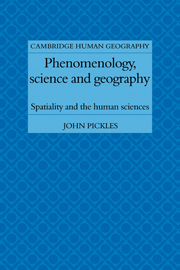Book contents
- Frontmatter
- Contents
- Preface
- Acknowledgements
- 1 Introduction
- PART I GEOGRAPHY AND TRADITIONAL META-PHYSICS
- PART II GEOGRAPHY AND PHENOMENOLOGY
- PART III PHENOMENOLOGY AND THE QUESTION OF HUMAN SCIENCE
- PART IV HUMAN SCIENCE, WORLDHOOD AND SPATIALITY
- 8 Implications for the human sciences and a human science of geography
- 9 Towards an understanding of human spatiality
- Notes
- References
- Index
9 - Towards an understanding of human spatiality
Published online by Cambridge University Press: 07 September 2010
- Frontmatter
- Contents
- Preface
- Acknowledgements
- 1 Introduction
- PART I GEOGRAPHY AND TRADITIONAL META-PHYSICS
- PART II GEOGRAPHY AND PHENOMENOLOGY
- PART III PHENOMENOLOGY AND THE QUESTION OF HUMAN SCIENCE
- PART IV HUMAN SCIENCE, WORLDHOOD AND SPATIALITY
- 8 Implications for the human sciences and a human science of geography
- 9 Towards an understanding of human spatiality
- Notes
- References
- Index
Summary
The space about us here is merely space, no meaner or grander than the space above the shacks and tenements and temples and offices of the capital. Space is space, life is life, everywhere the same.
(Coetzee, 1982, 16)Whatever variety of existing theory about geometric space is taken, be it Euclidean, Lobatchevsky's, Riemann's, Minkowski–Einstein's, or the ‘n-dimensional’ notion of G. Cantor, it cannot be used to locate sociocultural phenomena, nor their spatial relationship to one another.
(Sorokin, 1962, 359)Geography, world and space
The themes with which geographers have traditionally claimed to be concerned are world, environment and nature, particularly insofar as they relate to man and earth. We have seen how this relationship has recently been interpreted formally as a spatial relationship, where space is the organizing principle for geographic entities (Whittlesey, 1957). Yet this view has been challenged, notably by the schools of geography concerned less with spatial relations per se and more with the sense of place (genius loci), landscape, region, and man–environment and man–nature relationships; with the creation of particular worlds and their interpretation of man's relationship with the land. Here space and spatial relations are subsets of these relationships, not the organizing principle itself. Consequently the geographic tradition displays and retains a certain inherent tension and ambiguity with regard to its basic subject-matter and approaches to it.
- Type
- Chapter
- Information
- Phenomenology, Science and GeographySpatiality and the Human Sciences, pp. 154 - 170Publisher: Cambridge University PressPrint publication year: 1985



